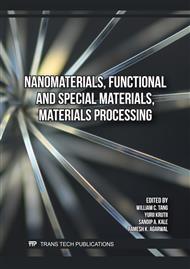p.3
p.13
p.25
p.39
p.45
p.53
p.59
p.65
p.71
Fabrication and Characterization of NaOH-Treated Nito (Lygodium circinnatum) Fiber-Reinforced Composite
Abstract:
This study explores the potential of Lygodium circinatum (commonly known as Nito vine), an underutilized natural fiber in polymer composites, as reinforcement in epoxy-based polymer composites. With the growing shift toward sustainable alternatives to synthetic fibers, Nito fiber presents an eco-friendly and cost-effective option. Sodium hydroxide (NaOH) treatment was applied to modify the fiber surface, and its effects on the fiber–matrix interaction, thermal stability, and mechanical performance were evaluated. FTIR analysis confirmed the successful reduction of non-cellulosic components such as hemicellulose in the treated fibers. SEM micrographs revealed enhanced interfacial bonding between the NaOH-treated fibers and the epoxy matrix, with reduced signs of debonding. Thermogravimetric analysis indicated improved thermal stability in composites containing treated fibers, as reflected by a higher degradation temperature. Mechanical properties such as tensile and flexural strength and modulus, as well as impact resistance, however, did not exhibit significant improvements, which might also be affected by the variability in the natural fibers and the hand lay-up method. These findings emphasize both the promise of Nito fiber as a viable natural reinforcement and the importance of consistent processing methods in composite fabrication. Overall, this work supports the favorable transition toward natural fibers in composite applications, particularly where thermal performance is prioritized.
Info:
Periodical:
Pages:
45-50
Citation:
Online since:
November 2025
Keywords:
Price:
Сopyright:
© 2025 Trans Tech Publications Ltd. All Rights Reserved
Share:
Citation:


